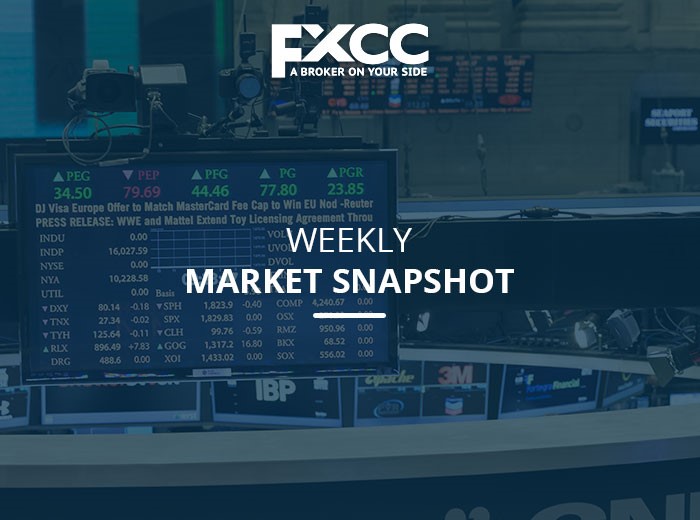Several factors dominated the trading week ending December 4. Covid and the optimism of vaccines, Brexit, the dying embers of the Trump administration, and stimulus discussions by central banks and governments. These are ongoing macroeconomic issues that will most likely dictate the trends and patterns we see on our FX charts and timeframes over the coming days and weeks.
The Covid effect on equity markets
Despite the vaccine euphoria which developed during the week, various governments are wrestling with the challenge to distribute the vaccines without affecting the potency. Pfizer’s drug is only effective at -70c, so transporting such an untested drug through a supply chain until it reaches someone’s arm represents a logistical task previously never undertaken. Also, we don’t know if the vaccine prevents asymptomatic transfer or how long it lasts.
The USA has recorded close to 3,000 deaths and 200,000 positive cases each day over recent days and experts predict these numbers will get worse unless the USA adopts a unified compulsory mask-wearing policy. Without this measure, the country is facing over 450K deaths by March 1, according to John Hopkin’s University projection. Joe Biden is proposing a 100-day mask-wearing policy to after his inauguration.
Irrespective of the Covid death and cases numbers reaching record highs, USA equity indices have powered ahead, taking out record highs. There’s no mystery why Wall Street is booming while Main Street collapses; the fiscal and monetary stimuli locked into markets. There is no evidence of trickle-down; twenty-five million American adults are currently in receipt of out of work benefits, but markets take out record highs.
USD slump appears to have no end in sight
The US dollar has been slumping dramatically over recent weeks. Both the Trump administration and the incoming Biden administration are unlikely to address this issue.
The weaker dollar has one critical benefit; it makes exports cheaper, the flip side is inflation rises, but in a ZIRP (zero interest rate policy) environment inflation should be kept in check.
The collapsing dollar is an inevitable consequence of the trillions of dollars’ worth of stimuli the Fed and USA govt have indulged in to revive a Covid battered economy. If Congress and the Senate can finally approve another tranche of stimulation over the coming week, we can expect the dollar to remain weak.
During the London trading session on Friday morning, the dollar index (DXY) traded close to flat at 90.64. When you bear in mind that the index has held a position close to 100 over recent years, the collapse becomes measurable. The DXY is down close to -6% year to date, and down -1.29% weekly.
The USD value versus the euro also measures the lack of desire to hold dollars. And it’s worth noting that the ECB is running ZIRP and NIRP policies which shouldn’t denote the euro as a safe-haven option. EUR/USD was trading up 0.13% in the morning session; it’s up 2.93% monthly and 8.89% year to date.
At 1.216 the most traded currency pair is trading at a level not seen since April-May 2018. When observed on a daily chart, the trend is visible from the end of November, and swing traders will have to monitor the situation carefully perhaps by adjusting their trailing stops to ensure they bank a percentage of the gains.
The impending Brexit hasn’t hit the value of sterling yet
The UK is now 27 days away from exiting the 27 nation EU trading bloc, and despite the UK govt pushing last-minute face-saving propaganda, a straightforward fact remains; the UK is losing single market access. People, goods, money and services will no longer be able to move on a frictionless basis and without tariffs.
Analysts and market commentators need to take their eyes off their charts and comprehend the practical chaos that will ensue from January 1. The UK is an economy 80% reliant on services and the consumer, seven-mile lorry tailbacks at UK ports will concentrate minds. Already haulage associations are telling the public to expect empty shelves in supermarkets.
Dollar weakness across the board has been favourable for GBP; sterling has risen sharply versus USD for two reasons; the dollar weakness and Brexit optimism. The slump of USD over recent weeks has probably disguised the insecurity surrounding GBP.
In the London session on December 4, GBP/USD was trading down -0.25% after both Brexit negotiation teams issued statements suggesting talks were collapsing.
The British team has deliberately focused on fishing, which as an industry accounts for less than 0.1% of the UK GDP. The maritime issue stokes feeling of nationalism and patriotism amongst those Brits who read the less cerebral publications.
GBP/USD is up 2.45% monthly and 2.40% year to date. The current price is some distance from the parity between USD and GBP many analysts confidently predicted this time last year, a Black Swan pandemic has had many unforeseen and unintended consequences.
Sterling has registered gains versus the euro during 2020, and in the early session, the cross-currency pair EUR/GBP traded at 0.905 up 0.33% while threatening to breach R1. EUR/GBP is up 6.36% year to date. This rise, coupled with the antipodean currencies NZD and AUD also being up versus GBP, illustrates to overall weak sentiment and nervousness to hold UK pounds. The pound is also down -2.31% versus yen during 2020.
Gold has glittered as a safe haven during 2020
Even holders of physics PhDs would struggle to explain why equity markets have risen in the USA and other countries to record highs, while safe havens such as the Swiss franc, Japan’s yen and precious metals have enjoyed significant gains.
Gold is up 20% year to date while silver is up 34.20%. Silver has slipped under the radar. When the initial impact of the Covid pandemic was trashing markets in March and April, physical silver was hard to obtain.
Other than acquiring the PM through digital/virtual means buying it in a physical form made complete sense for small investors. An ounce of silver is less than $25, an ounce of gold is $1840. It’s a simple choice for many small (but clued-up) investors, who lost their trust in governments and the money supply.
Next week’s economic calendar events to diarise
Traders should monitor all the afore-mentioned macroeconomic and political issues next week, over and above the data releases and announcements listed in the calendar. Suppose the USA government can’t agree to more fiscal stimulus and if Covid cases and deaths rise internationally and if the Brexi issues can’t be resolved. In that case, USD, GBP and EUR will be affected.
However, calendar data releases and events still have the power to move our forex markets, and next week has some exciting events scheduled.
The various ZEW sentiment readings for Germany get published on Tuesday, December 8. The forecast is for a fall, which could indicate Germany’s sectors are still feeling the impact of the Covid related slump.
Canada will announce its interest rate decision on Wednesday 9, and the forecast is for no change. CAD has risen by 1.67% versus USD over the past week. If the BoC lowers the rate from 0.25% to 0.00%, these gains could come under pressure. On Thursday the UK ONS will publish the latest GDP data. The Reuters forecast is for a fall from 1% growth registered in the previous month. The QoQ reading is also forecast to fall from 15.5% recorded for Q2. The ECB also reveal their interest rate decisions; the borrowing rate is forecast to stay at 0.00%, with the deposit rate negative at -0.25%. There is no suggestion that the ECB will take the headline rate below 0.00% at this stage in the Covid crisis.


